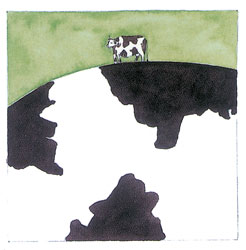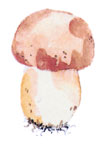

There is no doubt that the Italians cook the finest veal dishes anywhere in the world. It is their number one meat and I have found great pleasure—probably only in the last seven or eight years—in learning how to roast veal properly. Not only veal, in fact, but pork and lamb too. This type of cooking is called “wet roasting” in Italy. It involves seasoning the roast, then scaling and coloring it in butter or oil. White wine is added, perhaps with a scrap of garlic and some chopped-up tomato, suitable herbs, and maybe a squeeze of lemon juice. All this serves to moisten and flavor the meat as it roasts. Some of this “wet roasting” actually takes place completely on the burner and never goes into the oven. The meat is frequently turned as the juices gently reduce and attach themselves to the roast. The final result should be no more than a few tablespoons with which to anoint the slices of meat as opposed to drowning them. If we are talking gravy, this is the best. And it makes itself.
It is a pity that the ubiquitous escalope or scaloppina has had such a rough time in the past. Its life has been just one long trudge through soggy breadcrumbs, cheese, and ham slices and finally blanketed with thick, white sauces. I think it could be called the trattoria story. This slice of veal is for simple preparations. A little lemon juice, a few sage leaves and some butter, a dash of Marsala perhaps. Chopped artichokes, some roasted peppers or grilled slices of fennel might be suitable accompaniments. And my favorite of all is the one where a thin slice of prosciutto is pressed into the meat along with a sage leaf. I know this dish—Saltimbocca alla Romana—is famous the world over, but have you ever had a good one?
Shin of veal is a magnificent cut. The great thing about it is that it is tender enough to roast as well as being braised gently or cut into thick slices for osso buco. Cooked in its whole piece it is called stinco, the English translation being shank or shin, I presume.

This is my favorite cut of veal by far. Do not be put off by thoughts of tough meat or difficulty when it comes to carving. A shin of veal can look unwieldy when you see the whole thing, but ask your butcher to saw right through the bone at the thin end of the shin, about an inch above the meat. This releases the tendons and allows the meat, while it is roasting, to shrink down the bone and “collect” at one end.
1 prepared shin of veal (see above)
4 garlic cloves, peeled and sliced
2 rosemary sprigs
salt and pepper
a little flour
6 tbsp olive oil
6 tbsp butter
½–¾ 750 ml-bottle of dry white wine
Preheat the oven to 375°F. Make deep incisions in the meat with a small knife and push the slices of garlic and little bits of rosemary into these. Season all over with salt and pepper and rub with the flour. This helps form a crust on the meat and helps with the gravy too. Melt the olive oil and butter in a heavy-bottomed roasting pan, on the burner. When foaming, put in the shin and brown very well on all surfaces. Put in the oven for 20–30 minutes, basting occasionally. Take out, tip off most of the fat, and add some of the white wine. Turn the temperature down to 325°F and roast for a further 1½ hours, topping up with splashes of white wine now and again when needed. This is one of those “wet roasting” dishes (see here) and the wine, combined with the juices that will drip from the meat, constitutes the gravy. Transfer the shin to a serving dish and keep warm. Put the gravy back on the burner and stir and scrape around to make sure that any gooey bits are lifted from the bottom. Taste for seasoning and, if too strong or too salty, then add a little water. The consistency should be one of juice rather than sauce, and the color should be mahogany. When carving, hold the “handle” of the bone and carve downward in chunks rather than thin slices. Flageolet or haricot verts beans in a creamy sauce are very good with this.
A trattoria standby, good old saltimbocca can be really delicious. And I have often found that it is one of the safest choices when you feel a little dubious about some of the other dishes on offer. It takes literally minutes to cook and is a truly perfect marriage of flavors.
8 veal escalopes, beaten very thin between waxed paper
pepper
16 sage leaves
8 paper-thin slices of prosciutto
6 tbsp butter
all-purpose flour for coating
salt
1 small glass of dry white wine
a splash of Marsala (optional)
4 lemon wedges
Grind pepper over one side of the veal escalopes. Place one sage leaf on each escalope and cover with a slice of prosciutto so that it fits as neatly as possible to the shape of the escalope. Fold in half, put back in the waxed paper, and lightly beat to sandwich the two together. Melt the butter in a large frying pan until about to turn nut brown. Quickly dip the saltimboccas in the flour and fry briefly on either side until golden brown, about 2 minutes a side. Do this in two batches if necessary to avoid overcrowding. Keep warm in a low oven. While the fat is still hot, throw in the remaining sage leaves and sizzle for a few moments until they are crisp. Lift them out onto paper towels, sprinkle with salt, and put them on top of the veal in the oven. Tip out most of the fat and pour in the wine and Marsala, if using. Allow to bubble and reduce until it forms a light, syrupy gravy. Spoon this over the saltimboccas, and serve immediately with the lemon wedges. Delicious with mashed potato and buttered spinach.
Traditionally, tongue with Madeira sauce would refer to salt ox tongue. This is absolutely delicious in its own right. But I thought, as I wanted to give a recipe for calves’ tongue, it would be useful, and interesting, to give a good brine recipe (which comes from Jane Grigson’s Charcuterie and French Pork Cookery) to salt the tongue yourself. Plain, boiled calves’ tongue needs a sauce such as ravigote (see here) or mustard sauce; certainly something piquant. Madeira sauce would be too rich. The salting process hardens the meat somewhat and gives it a sharper taste, which then marries wonderfully with the Madeira sauce.
The brine recipe is given in its original quantities and I would halve it for two tongues. It seems sensible to give the full quantities because having a brine bath sitting around is very useful for all sorts of things. You could brine your own pieces of pork and beef—particularly belly pork—which is the classic Petit Salé (see here) that you see all over France, served with lentils. Brine keeps for ages in a cool place. Saltpeter is a preservative and available from pharmacies. Soak the tongues for three days in the brine, so make it in advance.
2 carrots, peeled and chopped
2 onions, peeled and quartered
3 celery stalks, chopped
3 thyme sprigs
2 bay leaves
1 tsp peppercorns
2 tbsp red wine vinegar
10 cups water (Jane Grigson specifies soft or rain water. Use mineral if you feel strongly about it)
¾ cup sea salt
1½ cups packed brown sugar
¼ cup saltpeter
1 tsp juniper berries
a pinch of grated nutmeg
2 bay leaves
3 thyme sprigs
1 tsp black peppercorns
4 cloves
2 tbsp butter
2 bacon slices, chopped
1 small onion, peeled and finely chopped
1 small carrot, peeled and finely chopped
1 celery stalk, finely chopped
1 leek, washed and trimmed, finely chopped
2 tsp tomato purée
1 heaped tsp all-purpose flour
¾ cup plus 2 tbsp dry Madeira
3 tbsp Meat Glaze (see here)
salt and pepper
¼ cup butter
1 tbsp chopped parsley
To make the brine, boil together the water, sea salt, brown sugar, and saltpeter. Coarsely grind the herbs and spices and add to the liquid. Cover and leave to cool completely. Strain into a stainless steel or china dish. It is now ready for use. Soak the tongues in the brine for 3 days, then drain.
Put the tongues, vegetables, herbs, peppercorns, and vinegar in a large pan. Cover with cold water, bring to a boil, and simmer gently, covered, for 2 hours or until very tender when tested with a thin skewer—there should be no resistance. Turn off the heat and keep warm in the liquid. This, by the way, can be done a day in advance.
Meanwhile, to make the sauce, fry the bacon in the 2 tbsp butter until crisp. Add the vegetables, stir until well colored, and add the tomato purée. Carry on cooking over a low heat until the tomato purée has turned a rusty red color. Stir in the flour and cook gently for a few minutes, stirring constantly, so that it is well blended into the vegetables. Heat the Madeira in a small pan, ignite with a match, and boil until the flames have subsided. Add to the vegetables with the meat glaze and stir until smooth. Season with salt and pepper. If you find the sauce is too thick, add a little of the cooking liquor from the tongues. Conversely, if you find that the sauce is too thin, allow it to reduce slightly. Whichever is the case, the sauce should simmer gently for at least 20 minutes to attain a syrupy consistency that is going to coat the slices of pink calves’ tongue. Strain the sauce through a very fine sieve, pressing well against the solids with the back of a ladle to extract all the flavor. Reheat gently, removing any scum that forms in the process. Keep warm.
While the tongue is still warm, peel off the skin. Cut the tongue into slices and arrange on a serving dish. Over a gentle heat, whisk the ¼ cup butter into the sauce and spoon over the meat. Sprinkle with the chopped parsley and serve with spinach and boiled potatoes.